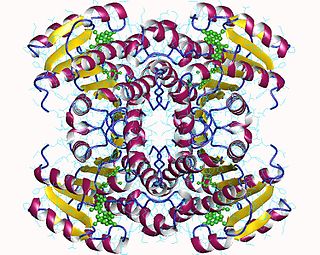15-hydroxyprostaglandin dehydrogenase may refer to:
15-hydroxyprostaglandin dehydrogenase may refer to:
A dehydrogenase is an enzyme belonging to the group of oxidoreductases that oxidizes a substrate by reducing an electron acceptor, usually NAD+/NADP+ or a flavin coenzyme such as FAD or FMN. They also catalyze the reverse reaction, for instance alcohol dehydrogenase not only oxidizes ethanol to acetaldehyde in animals but also produces ethanol from acetaldehyde in yeast.

Nicotinamide adenine dinucleotide phosphate, abbreviated NADP+ or, in older notation, TPN (triphosphopyridine nucleotide), is a cofactor used in anabolic reactions, such as the Calvin cycle and lipid and nucleic acid syntheses, which require NADPH as a reducing agent. It is used by all forms of cellular life.

Isocitrate dehydrogenase (IDH) (EC 1.1.1.42) and (EC 1.1.1.41) is an enzyme that catalyzes the oxidative decarboxylation of isocitrate, producing alpha-ketoglutarate (α-ketoglutarate) and CO2. This is a two-step process, which involves oxidation of isocitrate (a secondary alcohol) to oxalosuccinate (a ketone), followed by the decarboxylation of the carboxyl group beta to the ketone, forming alpha-ketoglutarate. In humans, IDH exists in three isoforms: IDH3 catalyzes the third step of the citric acid cycle while converting NAD+ to NADH in the mitochondria. The isoforms IDH1 and IDH2 catalyze the same reaction outside the context of the citric acid cycle and use NADP+ as a cofactor instead of NAD+. They localize to the cytosol as well as the mitochondrion and peroxisome.

Glucose-6-phosphate dehydrogenase (G6PD or G6PDH) (EC 1.1.1.49) is a cytosolic enzyme that catalyzes the chemical reaction

In enzymology, a carbonyl reductase (NADPH) is an enzyme that catalyzes the chemical reaction
In enzymology, a malate dehydrogenase (NADP+) (EC 1.1.1.82) is an enzyme that catalyzes the chemical reaction
In enzymology, a prostaglandin-E2 9-reductase (EC 1.1.1.189) is an enzyme that catalyzes the chemical reaction
In enzymology, a 15-hydroxyprostaglandin-D dehydrogenase (NADP+) (EC 1.1.1.196) is an enzyme that catalyzes the chemical reaction

Hydroxyprostaglandin dehydrogenase 15-(NAD) (the HUGO-approved symbol = HPGD; HGNC ID, HGNC:5154), also called 15-hydroxyprostaglandin dehydrogenase (NAD+), (EC 1.1.1.141), is an enzyme that catalyzes the following chemical reaction:
In enzymology, a 15-hydroxyprostaglandin dehydrogenase (NADP+) (EC 1.1.1.197) is an enzyme that catalyzes the chemical reaction
In enzymology, a 15-hydroxyprostaglandin-I dehydrogenase (NADP+) (EC 1.1.1.231) is an enzyme that catalyzes the chemical reaction
In enzymology, a 3alpha-hydroxysteroid dehydrogenase (B-specific) (EC 1.1.1.50) is an enzyme that catalyzes the chemical reaction

In enzymology, a 3-hydroxybutyryl-CoA dehydrogenase (EC 1.1.1.157) is an enzyme that catalyzes the chemical reaction
In enzymology, a [isocitrate dehydrogenase (NADP+)] kinase (EC 2.7.11.5) is an enzyme that catalyzes the chemical reaction:

Hydroxyprostaglandin dehydrogenase 15-(NAD), also called 15-hydroxyprostaglandin dehydrogenase [NAD+], is an enzyme that in humans is encoded by the HPGD gene.

Isocitrate dehydrogenase [NADP], mitochondrial is an enzyme that in humans is encoded by the IDH2 gene.
Malic enzyme may refer to decarboxylating malate dehydrogenases:
Malate dehydrogenase is an enzyme that reversibly catalyzes the oxidation of malate to oxaloacetate using the reduction of NAD+ to NADH.
Unqualified, glyceraldehyde-3-phosphate dehydrogenase usually refers to the enzyme glyceraldehyde-3-phosphate dehydrogenase.